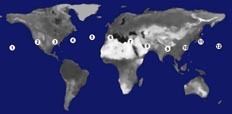 | ||
Sunpendulum is an art, science and technology project devised by Austrian media artist Kurt Hofstetter.
Contents
Concept
Twelve video cameras called "time-eyes" are connected to the internet in twelve locations in twelve time zones around the Earth, observing the sky twenty four hours per day, continuously creating a hypothetical "sun clock" which spans the planet.
→ Note: This section describes "pavilions" which have not been constructed or installed.
At a location to be determined within each time zone, twelve screens are intended to be arranged in a circle within a pavilion meant to remain open for visitors twenty four hours per day. The screens, connected online with the time-eyes, transmit the images from the twelve time zones. As the earth rotates, the images transmitted by the time-eyes move within a pavilion's circle of screens where day and night may be vicariously experienced in parallel.
Each pavilion, a circular structure of twenty four pairs of half cylinders, each pair of which resembles in horizontal cross section the Hopi symbol ( ) for universal brotherhood, is intended to allow twenty four points of entry for visitors while preventing local light from reaching the screens. An arrangement of rooftop solar cells is hypothesized to produce the necessary energy.
Kernel team
The kernel team consists of scientists (chiefly from the Institute of Computer Graphics and Algorithms at the Vienna University of Technology) and artists. Its primary tasks are ongoing technical developments which maintain the integrity of the project and its hardware and software.
Collaboration partners
The collaboration partners are scientific and academic institutions which host the time-eye cameras, hardware and servers and participate in the project's international cross-cultural cooperation.
